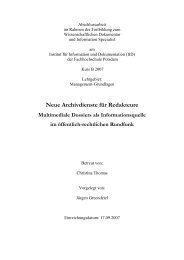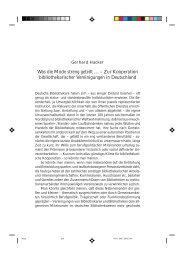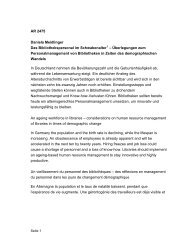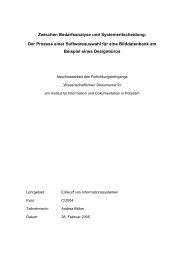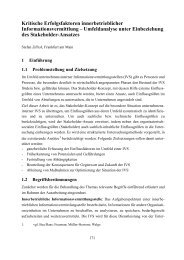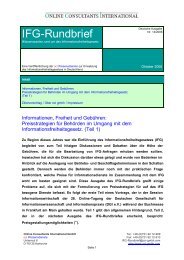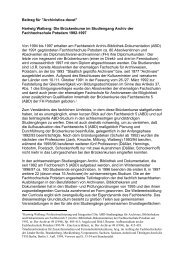PDF(886K) - Wiley Online Library
PDF(886K) - Wiley Online Library
PDF(886K) - Wiley Online Library
You also want an ePaper? Increase the reach of your titles
YUMPU automatically turns print PDFs into web optimized ePapers that Google loves.
the possibility of regarding the respective terms individually<br />
and linking them subsequently.<br />
If gen-identical objects are described by different terms<br />
at different times, these terms will be placed in the desired<br />
context via chronological relations. These relations are<br />
called “chronologically earlier” and—as the inversion—<br />
“chronologically later.” As an example, let us consider the<br />
city located where the Neva flows into the Baltic Sea:<br />
Between 1703 and 1914: Saint Petersburg<br />
1914–1924: Petrograd<br />
1924–1981: Leningrad<br />
Afterwards: Saint Petersburg again.<br />
Any neighboring concepts are chronologically linked:<br />
Saint Petersburg [Tsar Era] is chronologically earlier than<br />
Petrograd.<br />
Petrograd is chronologically earlier than Leningrad.<br />
The chronological relation is irreflexive, asymmetrical,<br />
and transitive.<br />
Two concepts are antonyms if they are mutually exclusive.<br />
Such opposite concepts are, for example, love – hate, genius –<br />
insanity, and dead – alive. We must distinguish between two<br />
variants: Contradictory antonyms know exactly two shadings,<br />
with nothing in between. Someone is pregnant or isn’t<br />
pregnant—tertium non datur. Contrary antonyms allow for<br />
other values between the extremes; between love and hate,<br />
for example, lies indifference. For contradictory antonyms it<br />
is possible, in retrieval, to incorporate the respective opposite<br />
concept—linked with a negating term such as “not” or<br />
“un-”—into a query. Whether or not contrary antonyms can<br />
meaningfully be used in knowledge representation and information<br />
retrieval is an open question at this point. Antonymy<br />
is irreflexive, symmetrical, and intransitive.<br />
Hierarchy<br />
The most important relation of concept systems, the supporting<br />
framework so to speak, is hierarchy. Emile Durkheim<br />
(1995 [1912]) assumes that hierarchy is a fundamental relation<br />
used by all men to put the world in order. As human<br />
societies are always structured hierarchically, hierarchy is—<br />
according to Durkheim—experienced in everyday life and,<br />
from there, projected onto our concepts of “the world.”<br />
If we do not wish to further refine the hierarchy relation<br />
of a KOS, we will have a “mixed-hierarchical concept system”<br />
(DIN 2331:1980, p. 6). It is called “mixed” because<br />
it summarizes several sorts of hierarchical relation. This<br />
approach is a very simple and naïve world view. We distinguish<br />
between three variants of hierarchy: hyponymy,<br />
meronymy, and instance.<br />
Hyponym-Hyperonym Relation<br />
The abstraction relation is a hierarchical relation that is<br />
subdivided from a logical perspective. “Hyperonym” is the<br />
term in the chain located precisely one hierarchy level higher<br />
than an initial term; “hyponym” is a term located on the<br />
lower hierarchy level. “Sister terms” (first-degree parataxis)<br />
share the same hyperonym. Concepts in hierarchical relations<br />
form hierarchical chains or concept ladders. In the<br />
context of the definition, each respective narrower term is created<br />
via concept explanation or—as appropriate—via family<br />
resemblance. If there is no definition via family resemblance,<br />
the hyponym will inherit all properties of the hyperonym.<br />
In the case of family resemblance, it will only inherit a partial<br />
quantity of the hyperonym’s properties. Additionally, it will<br />
have at least one further fundamental property that sets it apart<br />
from its sister terms. For all elements of the hyponym’s extension,<br />
the rule applies that they are also always elements of<br />
the hyperonym. The logical subordination of the abstraction<br />
relation always leads to an implication of the following kind<br />
(Löbner, 2002, p. 85; Storey, 1993, p. 460):<br />
IfxisanA,thenxisaB<br />
if A is a hyponym of B.<br />
If it is true that bluetit is a hyponym of tit, then the<br />
following implication is also true:<br />
If it is true that: x is a bluetit, then it is true that: x is a tit.<br />
The abstraction relation can always be expressed as an<br />
“IS-A” relation (Khoo & Na, 2006, p. 174). In the example<br />
Bird – Songbird – Tit – Blue Tit<br />
(defined in each case without resorting to family resemblance),<br />
it is true that:<br />
The bluetit IS A tit.<br />
The tit IS A songbird.<br />
The songbird IS A bird.<br />
Properties are added to the intension on the journey<br />
upwards: A songbird is a bird that sings. The bluetit is a<br />
tit with blue plumage. Mind you: The properties must each<br />
be noted in the term entry (keyword entry, descriptor entry,<br />
etc.) via specific relations; otherwise any (automatically<br />
implementable) heredity would be completely impossible.<br />
If we define via family resemblance, the situation is<br />
slightly different. In the example:<br />
Leisure Activity – Game – Game of Chance<br />
it is true, as above, that:<br />
A game of chance IS A game.<br />
A game IS A leisure activity.<br />
As we have delimited game via family resemblance, game<br />
of chance does not inherit all properties of game (e.g., not<br />
necessarily board game, card game), but only a few. The<br />
hyponym’s additional property (is a game of chance) is in this<br />
1960 JOURNAL OF THE AMERICAN SOCIETY FOR INFORMATION SCIENCE AND TECHNOLOGY—October 2010<br />
DOI: 10.1002/asi



